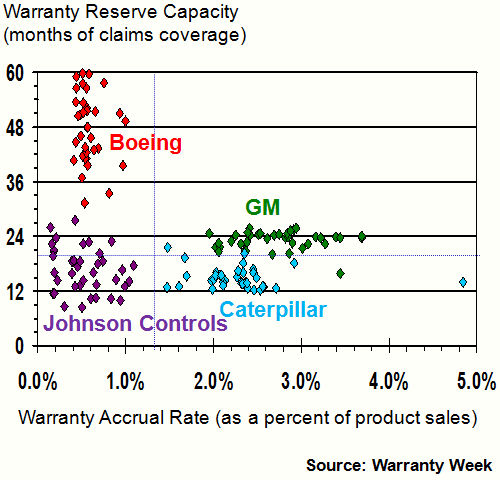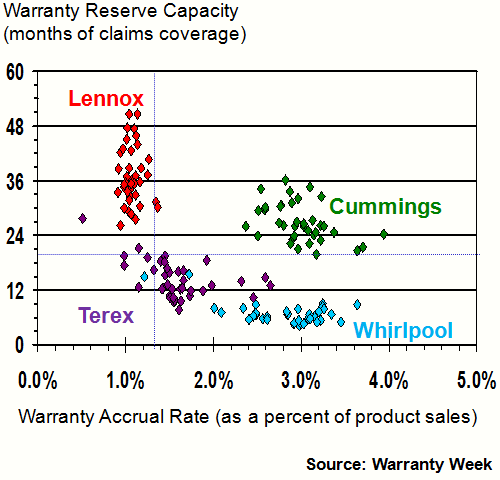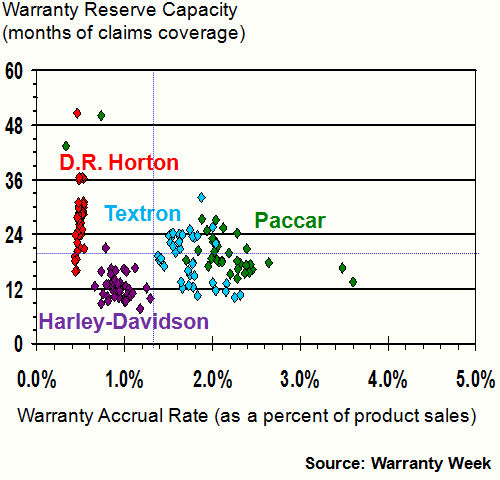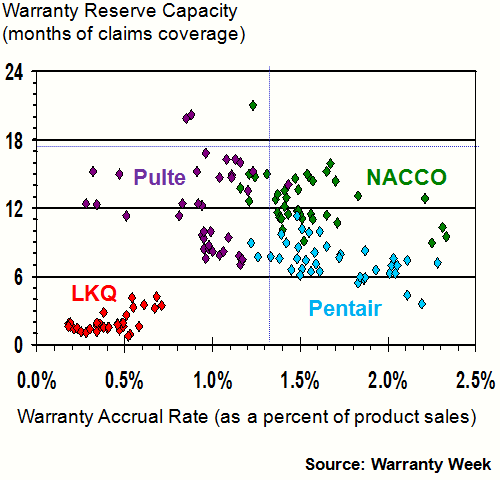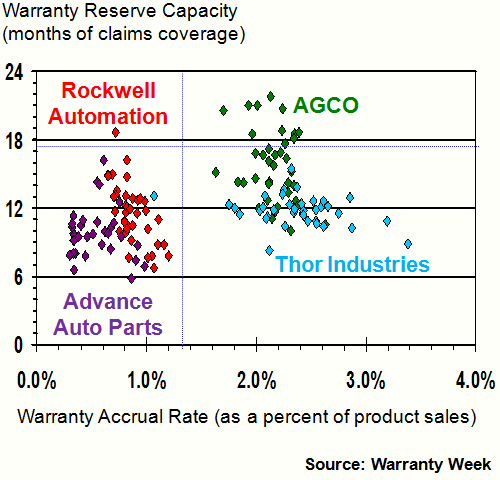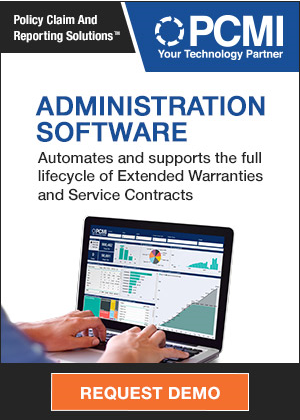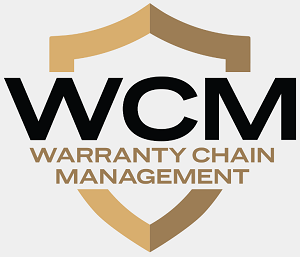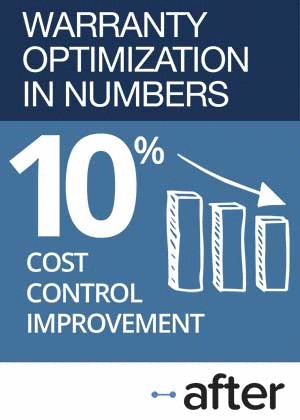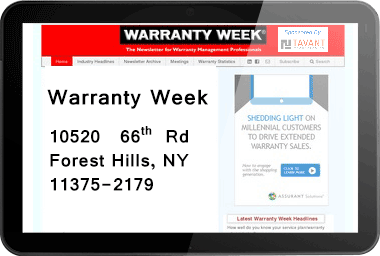Warranty Marksmen, Part 1:Given the average duration of a company's product warranties and the predicted repair cost, a company should be able to accurately estimate how much they need to set aside. But some companies are better at it than others.
Like a marksman facing a target, the people in charge of planning how much to set aside to pay warranty costs need to take careful aim with their estimates.
And like a good marksman's target, a quick look at the results are all that's needed to determine skill. Whether the holes are in a tight cluster, or whether they're scattered all over, has a direct relationship to the marksman's aim.
Of all a company's warranty metrics, the average duration of a product warranty is among the slowest to change. Yet if a company doesn't take careful aim, it may have 20 months of funds in its warranty reserve, while a year later it may have only 9 months. That's because the amount of claims a company pays each month is among the metrics that are fastest to change.
However, a good marksman knows how to aim. And the warranty accrual rate is among the easiest metrics to modify and control. So it is possible to compensate for changing claims rates, and to stay on target.
This week and next, we're going to examine the aim of specific companies, looking for the best marksmen in the warranty business. This week, we'll look in the automotive and building trades, and next week we'll look in the high tech industry sectors. In each case, we'll chart the top 20 marksmen, based on the patterns they've produced over the past decade.
Starting With Basic Warranty Metrics
For each of the companies measured in the five charts below, we started out working with four warranty metrics and ended up with two ratios. The first metric we collected was the dollar amount of product sales for the period in question. The second and third metrics were the amount spent on warranty claims, and the amount set aside as warranty accruals, during the corresponding sales period. And the fourth metric was the balance in the warranty reserve fund at the end of each of the past 38 quarters (9-1/2 years).
Then we took the four basic metrics and combined them to create two ratios. The amount set aside as warranty accruals was divided by the dollar amount of product sales for the period in question. This created a percentage that is labeled in the charts below as the accrual rate. For instance, if a company sells $10 million worth of carpeting in a fiscal quarter and sets aside $100,000 in warranty accruals over the course of those same three months, its accrual rate would be 1.0%.
Next we took the balance in the warranty reserve fund at the end of each quarter, and divided it by the amount being spent per month on warranty claims. This created a metric we're calling the warranty reserve capacity, expressed as the number of months of claims coverage in the reserve fund. For instance, if the reserve fund contained $9 million and the company was spending $500,000 a month on warranty claims, the reserve capacity would be 18 months.
There are five charts with four companies in each. Therefore, there are 152 data points per chart, though not all will be visible because of overlap. The June 2012 average for all manufacturers (1.3% accruals and 17.7 months of claims-paying capacity) are marked by the spot where the dotted lines cross.
Each of the charts track two key assumptions that a company has to make: how much money should we set aside to pay future warranty claims, and are we keeping enough in the reserve given the duration of our warranties? And since the duration of a company's warranties is likely to change much more slowly than its accrual rate, we're going to suggest that a horizontal spread is better than a vertical spread.
Most Consistent Warranty Estimates
In the following five slides, therefore, we present the 20 largest and most consistent warranty providers in the automotive and building trades, arranged roughly in descending order by the amount of claims paid per year.
By consistent, we mean that their accrual rate and the ratio between claims and reserves has varied over a relatively short range in the 9-1/2 years between early 2003 and the middle of 2012. In the charts below, the tighter the pattern of data points, the more consistent a company's warranty metrics.
Figure 1
U.S.-based Manufacturers
Most Consistent Warranty Metrics:
Warranty Accrual Rate & Reserve Coverage
January 2003 to June 2012
(as a % of revenue & in months)
Notice in Figure 1 that there are three basic patterns. Boeing Co. keeps its accrual rate close to 0.6%, but allows the ratio between claims payments and reserves to vary between 36 and 60 months. This results in a vertical pattern.
General Motors Co. (and its predecessor General Motors Corp.) keep the ratio close to 24 months. But its accrual rate has been gradually reduced from 3.5% to 2.0%, resulting in a horizontal pattern.
Caterpillar Inc. and Johnson Controls Inc., meanwhile, have kept their warranty metrics within a tight cluster pattern. But there's no real bunching along a given horizontal or vertical axis, meaning that the companies are not sticking to a given number no matter what. Instead, the data points are mostly within a rectangular box in one section of the chart.
No Frequent Cost-Cutters
In the November 1 newsletter, we listed the 20 companies that have most frequently reduced their accrual rates over the past decade: Axcelis Technologies Inc.; Boston Scientific Corp.; Broadcom Corp.; Cymer Inc.; Harris Corp.; Hologic Inc.; Juniper Networks Inc.; Lear Corp.; LSI Corp.; MTS Systems Corp.; Newport Corp.; Nvidia Corp.; Raytheon Co.; Rofin-Sinar Technologies Inc.; SanDisk Corp.; St. Jude Medical Inc.; SunPower Corp.; Valspar Corp.; Waters Corp.; and Woodward Inc.
In this week's charts, had any of them made the cut, their patterns would have resembled those of General Motors or Whirlpool: a wide horizontal spread with little vertical change. This is the pattern of a company that reduces its accrual rate but always keeps enough funds in the warranty reserve to cover claims.
In Figure 2, Lennox International Inc. follows the vertical pattern while Cummins Inc. and Terex Corp. fit within a box. However, both Whirlpool and Terex have a few data points that are far outside their "zone," suggesting a misfire or two over the past decade.
Figure 2
U.S.-based Manufacturers
Most Consistent Warranty Metrics:
Warranty Accrual Rate & Reserve Coverage
January 2003 to June 2012
(as a % of revenue & in months)
The Whirlpool accrual rate pattern seems safely clustered around 2.5% to 3.5%. This is a mark of consistency, as is the relatively small amount of vertical spread. However, most of these data points are far below 12 months, meaning that the appliance manufacturer is keeping its reserves-to-claims ratio much leaner than the average length of its product warranties would seem to encourage. But this would become a major source of concern only if for some reason the company's cash flow is radically reduced.
In the November 21 newsletter, the average reserve capacity for the appliance industry as a whole was more in the range of 12 to 18 months. So while the market leader is setting a lean-reserves example, the rest of the industry is not. Then again, Whirlpool is setting aside a much higher percentage of its revenue to finance warranty expenses than the others.
Constant Accruals, Varying Reserves
Lennox and Boeing, meanwhile, appear to be extremely consistent with their accrual rates, while letting their reserves-to-claims ratio meander all over the place. It's a characteristic they share with D.R. Horton Inc., as can be seen in Figure 3. Basically, they're choosing an accrual rate and are sticking with it, no matter how claims rates rise and fall. As a result, sometimes there are 3 or 4 years' worth of reserves, while other times there are 2 or 3 years. Unless the companies' warranties are getting longer and shorter as well, this is a sign of incomplete planning.
Figure 3
U.S.-based Manufacturers
Most Consistent Warranty Metrics:
Warranty Accrual Rate & Reserve Coverage
January 2003 to June 2012
(as a % of revenue & in months)
Harley-Davidson Inc., on the other hand, has perhaps the best aim of all the companies we're following this week. Virtually all of its data points are extremely close to each other, clustered around one percent and 12 months. This means the company keeps a close watch on all its warranty metrics, making sure it is setting aside enough funds to cover costs. However, this also means that Harley-Davidson is not too successful when it comes to cutting warranty costs.
Warranty Cost-Cutting
In the October 11, October 25, and November 1 newsletters, we looked for companies that were most frequently cutting warranty claims and accrual rates, compared to one year, three years, six years, and nine years ago. Of a possible eight cost reductions, Harley-Davidson had only one.
In contrast, Lennox was 5-for-8. D.R. Horton was 4-for-8, as was Boeing. In other words, the companies that look like they're sticking to a given accrual rate no matter what are still able to reduce their warranty expenses.
Also, out of the 20 companies we're examining this week, an incredible nine of them were either 7-for-8 or 8-for-8 in terms of warranty cost reductions. They are: AGCO Corp.; Caterpillar; Cummins; GM; NACCO Industries Inc.; Pentair Inc.; Rockwell Automation Inc.; Terex; and Whirlpool. Therefore, they are the champions of both consistent warranty estimates and consistent cost-cutting.
In Figures 4 and 5 we've changed the scale because the data points vary over much less an area. In the bottom left corner of Figure 4, LKQ Corp. lets its accrual rate vary over a very short range, and keeps the ratio between warranty reserves and claims payments in an extremely short 2-to-3-month range. However, given that its primary business is in rebuilt, recycled, reconditioned, and remanufactured auto and truck parts, this is perfectly understandable given the product line.
Pentair, Pulte and NACCO may seem to allow their key warranty estimates to vary more than the companies in the preceding charts, but keep in mind that the reduced scale makes them look more spread out. Incredibly, these are the 20 most consistent patterns among all the major warranty providers.
Figure 4
U.S.-based Manufacturers
Most Consistent Warranty Metrics:
Warranty Accrual Rate & Reserve Coverage
January 2003 to June 2012
(as a % of revenue & in months)
Finally, in Figure 5 we have four companies that follow a box pattern with their warranty estimates. And by that we mean that they allow both their accrual rate and the ratio between reserves and claims to vary over a somewhat wide range.
AGCO and Thor Industries, despite coming from very different industries (farm equipment and recreational vehicles), have very similar track records with their warranty estimates. Likewise, retailer Advance Auto Parts Inc. and industrial controls manufacturer Rockwell Automation are both below the U.S. average when it comes to their warranty metrics.
Figure 5
U.S.-based Manufacturers
Most Consistent Warranty Metrics:
Warranty Accrual Rate & Reserve Coverage
January 2003 to June 2012
(as a % of revenue & in months)
As we said, these are the 20 most consistent companies in the automotive and building trades when it comes to their key warranty metrics. So they're ahead of literally hundreds of other companies in terms of their consistency.
Next week, we'll take a look at just the high tech companies, which it turns out have even better aim than those in the automotive and building trades. It just so happened that once we'd whittled the list down to 40 companies, half were high tech and the rest were either automotive (13) or building trades (7).
|



